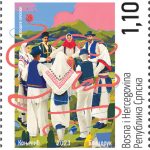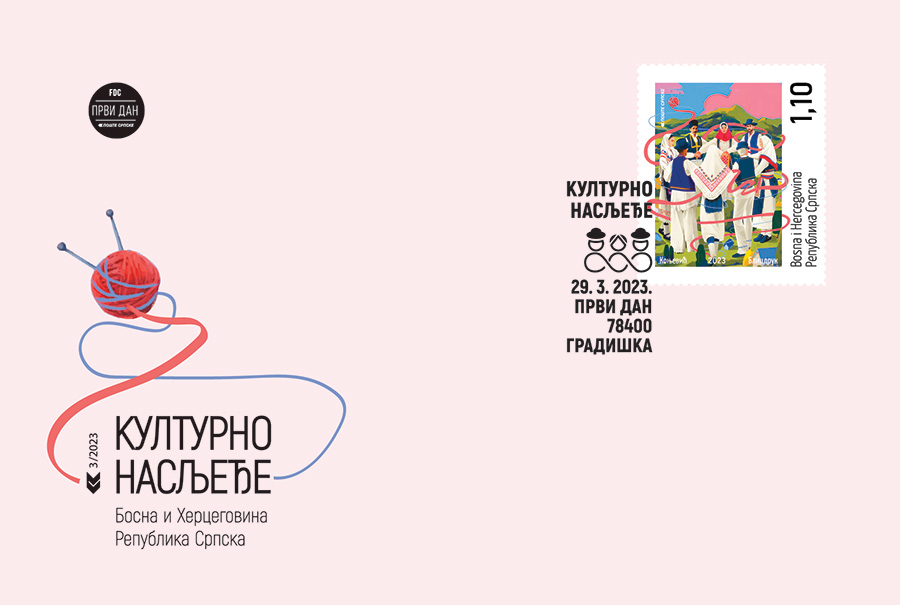Cultural Heritage 2023
Title:Cultural Heritage
Date of Issue: 29.03.2023.
Author: Natasa Konjevic
Type edition: commemorative
Printing techniques: multicolour offset
Sheet: 9
Paper: muflep 100g
Printing House: Blicdruk, Sarajevo
 Motive: ''Kozara kolo''
Motive: ''Kozara kolo''
Catalogue no.: 928
Perforation: 13 3/4
Face value: 1.10 BAM
Quantity: 10 000

One of the most important segments of the intangible cultural heritage of Kozara and Potkozarje is Gusto kolo (braided, from Kozara, and in people known as Kozara kolo). Its archaicness, but also its beauty in simplicity and the singing expression that gives to it rhythm and tact, have preserved Gusto kolo until today. The name of the Gusto kolo partly refers to the form in which it is danced - somewhere they call it densely because the dancers are close together, and somewhere knitted because the hands are intertwined in front of the body so that right hand is over left hand of dancers. Dancers begins performance of Gusto kolo with a small step to the left side with the right foot that accompanies the song, and when the song has faster song rhythm, dancers start dancing more intensely and faster. It is danced in circle that is closed and never opens, but it could be drawn into the center of the circle as if the dancers were swooping at those opposite them, and then they would respond in like manner to them. Into Gusto kolo was joined by young and old alike, it was the only opportunity where a girl would get close to a boy, because she always came to social events accompanied by an older family member.
The song is antiphonal presented through a dialogue of two groups of singers. Each group has at least three singers, one of whom leads and two accompanies the song. Gusto kolo is danced in a group of male and then group of female singers-dancers, there was no mixing - alternately catching male-female-male.
The main bearers of Gusto kolo are individuals, traditional vocal groups, experienced dancers and cultural and artistic societies, educational institutions. The traditional groups are from rural areas, while in cooperation with ensembles they transfer Gusto kolo to urban areas. Members of the traditional groups are traditionally men, and more recently women.
Both men and women played a role in preserving the Gusto kolo, and men played a significant role in preserving the song because only they sang while dancing. In addition to the traditional groups, in the middle of the 20th century, cultural and artistic associations became the bearers of the preservation of the chariot together with the traditional groups.
Author: Natasa Konjevic, academic artist and illustrator
Cooperation: Cultural and artistic association ''Kolovit'', Mirko Borjanovic Master - specialist in traditional dances
Graphic processing: Tanja Kuruzovic
 1371
1371  kontakt@postesrpske.com
kontakt@postesrpske.com


